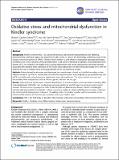Por favor, use este identificador para citar o enlazar a este item:
http://hdl.handle.net/10261/111638COMPARTIR / EXPORTAR:
 SHARE SHARE
 CORE
BASE CORE
BASE
|
|
| Visualizar otros formatos: MARC | Dublin Core | RDF | ORE | MODS | METS | DIDL | DATACITE | |

| Título: | Oxidative stress and mitochondrial dysfunction in Kindler syndrome |
Autor: | Zapatero-Solana, Elisabeth; García, Marta; García-Verdugo, José Manuel; Larcher, Fernando; Pallardó, Federico V.; Río, Marcela del | Palabras clave: | Kindlin1 Oxidative stress Mitochondria Keratinocytes Genodermatosis |
Fecha de publicación: | 2014 | Editor: | BioMed Central | Citación: | Orphanet Journal of Rare Diseases 9: 211 (2014) | Resumen: | [Background]: Kindler Syndrome (KS) is an autosomal recessive skin disorder characterized by skin blistering, photosensitivity, premature aging, and propensity to skin cancer. In spite of the knowledge underlying cause of this disease involving mutations of FERMT1 (fermitin family member 1), and efforts to characterize genotype-phenotype correlations, the clinical variability of this genodermatosis is still poorly understood. In addition, several pathognomonic features of KS, not related to skin fragility such as aging, inflammation and cancer predisposition have been strongly associated with oxidative stress. Alterations of the cellular redox status have not been previously studied in KS. Here we explored the role of oxidative stress in the pathogenesis of this rare cutaneous disease.
[Methods]: Patient-derived keratinocytes and their respective controls were cultured and classified according to their different mutations by PCR and western blot, the oxidative stress biomarkers were analyzed by spectrophotometry and qPCR and additionally redox biosensors experiments were also performed. The mitochondrial structure and functionality were analyzed by confocal microscopy and electron microscopy. [Results]: Patient-derived keratinocytes showed altered levels of several oxidative stress biomarkers including MDA (malondialdehyde), GSSG/GSH ratio (oxidized and reduced glutathione) and GCL (gamma-glutamyl cysteine ligase) subunits. Electron microscopy analysis of both, KS skin biopsies and keratinocytes showed marked morphological mitochondrial abnormalities. Consistently, confocal microscopy studies of mitochondrial fluorescent probes confirmed the mitochondrial derangement. Imbalance of oxidative stress biomarkers together with abnormalities in the mitochondrial network and function are consistent with a pro-oxidant state. [Conclusions]: This is the first study to describe mitochondrial dysfunction and oxidative stress involvement in KS. |
Descripción: | This is an Open Access article distributed under the terms of the Creative Commons Attribution License.-- et al. | Versión del editor: | http://dx.doi.org/10.1186/s13023-014-0211-8 | URI: | http://hdl.handle.net/10261/111638 | DOI: | 10.1186/s13023-014-0211-8 | ISSN: | 1750-1172 |
| Aparece en las colecciones: | (IIBM) Artículos |
Ficheros en este ítem:
| Fichero | Descripción | Tamaño | Formato | |
|---|---|---|---|---|
| Oxidative stress and mitochondrial.pdf | 2,62 MB | Adobe PDF |  Visualizar/Abrir |
CORE Recommender
PubMed Central
Citations
7
checked on 10-abr-2024
SCOPUSTM
Citations
16
checked on 19-abr-2024
WEB OF SCIENCETM
Citations
14
checked on 25-feb-2024
Page view(s)
358
checked on 24-abr-2024
Download(s)
271
checked on 24-abr-2024

